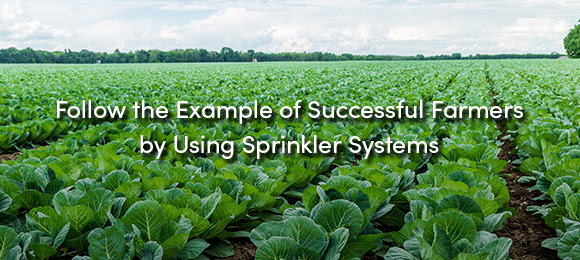
The greatest challenge in managing crop irrigation is to achieve uniform water application and system’s efficiency while protecting natural resources—soil and water. There are no uniform irrigation systems; some are more efficient while some are less. However, their efficiency mainly depends on conditions in which systems are installed, such as crop and soil type, field size and slope, as well as weather conditions in a given area.
A widely popular irrigation system among farmers, known for its considerable efficiency, is a sprinkler system. It's efficient, easy to install and maintain, suitable for all crops and soil types.
What Makes a Sprinkler Irrigation System?
Every sprinkler irrigation system consists of the following components:
- Pumping unit; a centrifugal pump which takes water from the source and provides adequate pressure for delivery into the pipe system
- Control head; maintains water demand and pressure in the system
- Main and sub-main lines; permanent or temporary pipes which deliver water from the pump to the laterals
- Laterals; portable pipes which deliver water from the mainlines or sub-main lines to the sprinklers
- Emitters/sprinklers; devices which distribute water through the air or the soil and deliver it to crops
- Accessories; valves, pressure regulators, couplers, risers
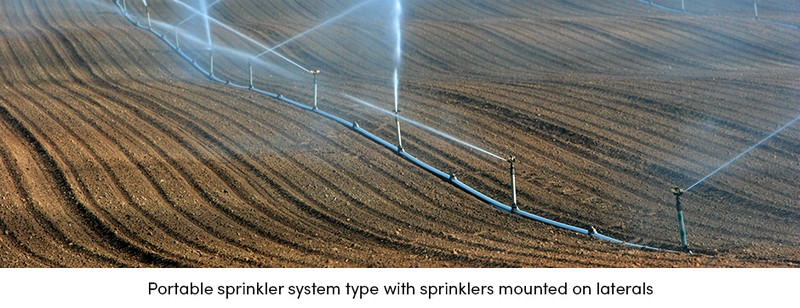
The main goal of a sprinkler system is to uniform water application to the crop root zone. Therefore, a farmer has to pay attention to three factors crucial for successful irrigation management.
These factors are as follows; wetting patterns, application rate, and emitter drop size which all vary on a sprinkler type and operational performance.
- Wetting pattern
Sprinklers operate under certain water pressure and make a wetting pattern. To achieve uniform wetting of crop root zone, several sprinklers must be placed together so their patterns overlap. The overlap should be at least 65% of the wetted diameter. This also determines the maximum spacing between sprinklers. Along with that, there are additional factors affecting sprinkler operation such as crop spacing, flow-rate, water quality, soil intake rate, and wind conditions.
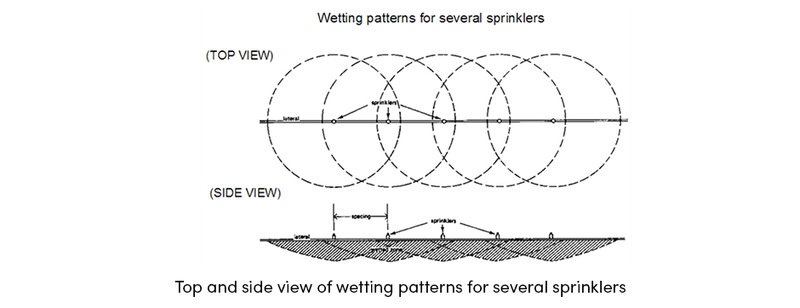
- Application rate
Application rate is the average rate at which water is applied to the crops. It depends mostly on the size of sprinkler nozzles, the operating pressure and the distance between the sprinklers.
Application rate plays an important role in the selection of a sprinkler system; we should have in mind that the average water application rate is less than the basic infiltration rate of the soil. Otherwise, the soil wouldn’t be able to absorb the applied water and runoff will occur.
- Sprinkler (emitter) drop size
As water sprays from a sprinkler, it breaks up into small drops 0.5- 4 mm (0.15-0.02 in) in size. The drop size is controlled by pressure and nozzle type. Low pressure creates larger drops thus affecting crops and soil. Additionally, nozzle type determines the flow-rate and water distribution pattern.
Sprinklers are usually mounted on risers of various heights, depending on a crop type and an irrigation technique. In this purpose, farmers can use static, rotating, pop-up, turbo-hammer, gun, and gear-driven sprinklers.
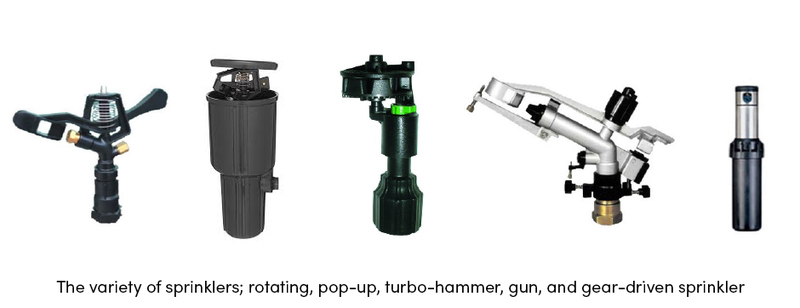
The Diversity of Sprinkler Systems
Regarding the sprinkler type as well as the system installation, there are various types of sprinkler irrigation systems:
- Hand-move; a portable system where irrigation pipes are moved from one field to another. Sprinkler height may be easily adjusted according to crop size. It is a low-cost irrigation system type but it requires severe labor.
- Side roll system; wheels move across the field with a lateral sprinkler line
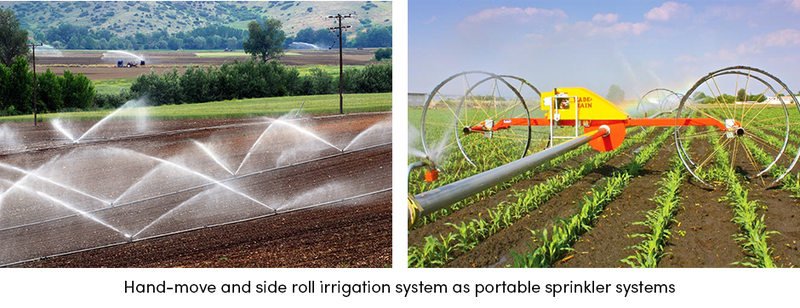
- Linear move system; a type of center pivot system with both lateral ends portable
- Center pivot system; the system where one lateral end is fixed while the other lateral is pivoting around it
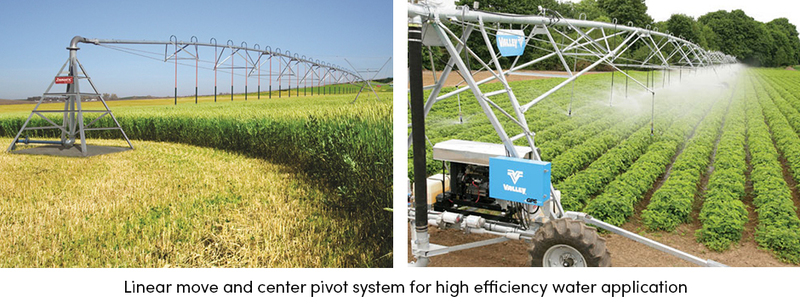
- Traveling gun system; high-pressure sprinkler mounted on a trailer which operates across the field. It can also be mounted on a portable stand and easily moved to another field.
- Stationary sprinkler systems; sprinkler systems mainly used in small gardens and lawn irrigation
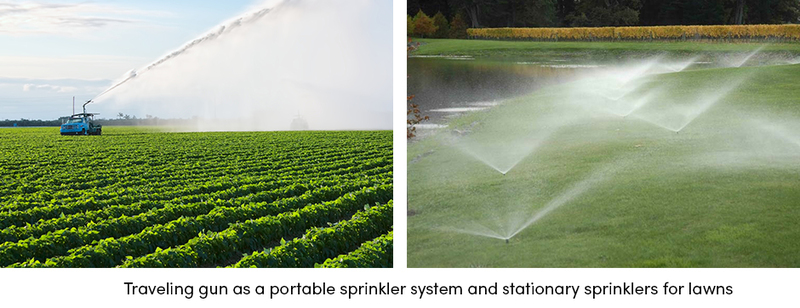
Sprinkler Irrigation Systems as a Solution for Global Food Problems
Irrigation is an important practice in every crop production. Worldwide, farmers are aware that irrigation is the only way to manage quality yield and successful production. Especially today, when there is a big threat by hazardous effects of climate change such as drought, frost, hail, and extreme temperatures which highly affect the amount of produced food.
Aiming to produce enough food for growing population, the irrigated land area is significantly increasing.
At this moment, only 20% of the total cultivated land is irrigated, which represents 40% of the total food produced worldwide. Despite the fact that 324 million ha are equipped for irrigation, not all area is irrigated, only 275 million ha.
Trying to adopt the climate change, farmers found the best way in sprinkler irrigation systems. Although they are not so efficient as a drip system, these systems provide uniform water application and the possibility to be used on any terrain and crop type. Additionally, sprinkler systems are number one in frost protection due to the application of rain-like water droplets which can reduce the plant stress caused by cool temperatures.

Besides that, sprinkler systems are also used for nutrient and pesticide application (fertigation). As a matter of fact, by setting a sprinkler irrigation system, a farmer can:
- Reduce water, pesticide and fertilizer use
- Prevent soil erosion
- Maintain soil productivity
- Reduce farm costs
- Increase yield quality and quantity.
Can Sprinkler Systems Be More Desirable than Drop-by-Drop?
Sprinkler irrigation is a system in which water is applied through sprinklers and distributed through pipelines to the field. This flexible and reliable system provides uniform water application over the entire field.
It’s important to mention that, although sprinkler systems are sophisticated, they also have some limitations. The most common ones are sensitivity to wind, high initial cost, and groundwater pollution with pesticide and fertilizer residue, and salt leaching, all as a consequence of overhead irrigation.
Despite these limitations, sprinkler systems have been lately highly improved in the area of their effectiveness and operational activities. Modern sprinkler systems have advanced controllers for watering schedule, high efficient nozzles (sprinklers) which reduce water usage, rain sensors which prevent watering prior to or after the rain, and freeze sensorswhich stop watering at freezing temperatures.
All these technological advancements of sprinkler systems can make this system more desirable than any other irrigation system type. And not only to farmers but to anyone who enjoys growing crops.
Sources: Agrivi





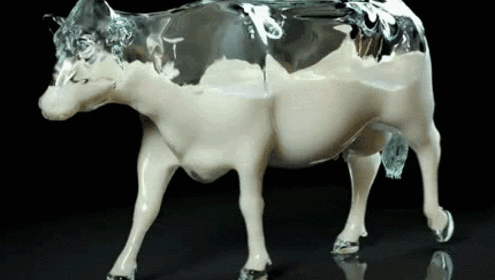






Comments (2)
Login or Register to add a comment